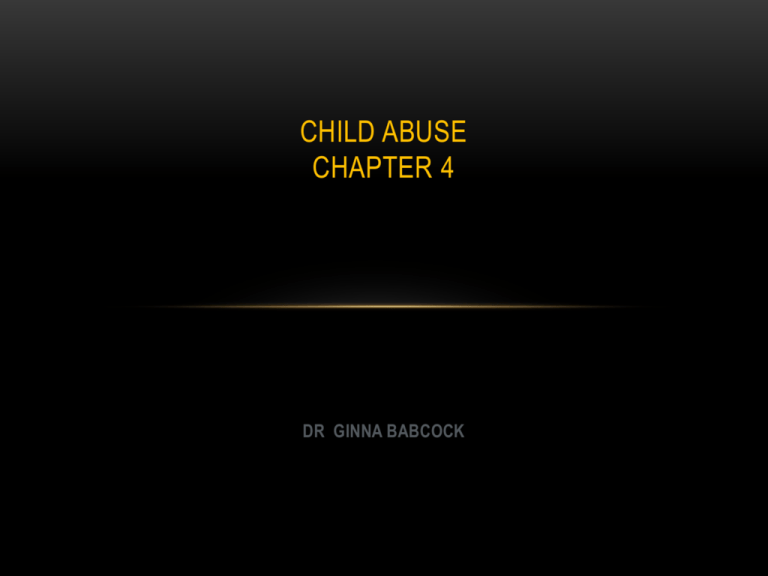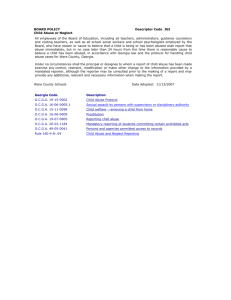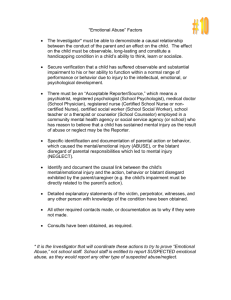
CHILD ABUSE
CHAPTER 4
DR GINNA BABCOCK
INTRODUCTION
•
Historical accounts tell us that some children have always been abused and neglected by one or both
parents; it is not uncommon or new
•
Child protective service (CPS) generally refers to agencies that are authorized by law to act on
behalf of a child when parents are unable or unwilling to do so
•
In all states, these agencies are required to investigate reports of child abuse and neglect and to
offer services to families when maltreatment has occurred
CHILD ABUSE AND NEGLECT TODAY
•
“Battered child syndrome” refers to repeated mistreatment or beating of a child resulting in
physical and psychological injuries
•
Millions of children are victims of fatal and non-fatal abuse and neglect each year
•
An estimated 31,000 deaths were attributed to homicide in the year 2002
•
Global data show that:
•
20% of women and 5 to 10% of men report having been sexually abused as children
•
Infanticide a problem in contemporary society
•
Children < 1 year at highest risk of death due to abuse and neglect
•
Fatalities rates for both boys and girls tend to decrease with age
TYPES OF ABUSE
•
•
According to the Administration on Children, Youth, and Families:
•
64.1 percent of child abuse victims experienced neglect;
•
16.0 percent were physically abused;
•
8.8 percent were sexually abused;
•
6.6 percent were psychologically abused
•
2.2 percent were medically neglected
It is not unusual for a victim to experience more than one form of abuse at the same time
EXAMPLES OF ABUSE AND NEGLECT
•
Physical assault (including excessive corporal punishment)
•
Sexual abuse or exploitation: forcible or consensual rape, incest, intercourse, sexual molestation, promoting prostitution, etc
•
Close confinement: tying or binding (or keeping children in a dog kennel, box, etc)
•
Abandonment or refusal to maintain custody (desertion)
Permitting/encouraging chronic maladaptive behavior: truancy, delinquency, prostitution, serious drug/alcohol abuse
Refusal to seek treatment for diagnosed physical, educational, emotional, or behavioral problem, or failure to follow the advice
of a competent professional
Failure to seek or delay in seeking medical care for a serious injury, illness, or impairment
•
Consistent or extreme inattention to child’s physical/emotional needs, including needs for food, clothing, supervision, safety,
affection, and reasonably hygienic living conditions
•
Failure to register or enroll the child in school
STATE DEFINITIONS
•
Child maltreatment subject to state laws and
administrative regulations
•
Definitions of child abuse and neglect located primarily in
three places:
•
Mandatory reporting statutes (civil laws);
•
Criminal statutes define those forms of child abuse
and neglect that are criminally punishable; and
•
Juvenile court jurisdiction statutes
EMOTIONAL/PSYCHOLOGICAL ABUSE
•
Most states include emotional maltreatment
in definitions of abuse and neglect
•
Typical language: “injury to the psychological
capacity or emotional stability of the child as
evidenced by an observable or substantial
change in behavior, emotional response, or
cognition”
•
…or as evidenced by anxiety, depression,
withdrawal, or aggressive behavior”
•
Mildest form occurs when a caretaker
belittles or ridicules a child frequently
WITNESSING FAMILY VIOLENCE
•
A child is witness to family violence when they
hear or see an act of family violence occurring
•
Legal definitions vary from state to state
•
15.5 million American children live in dualparent families with some form of violence in
the previous year
•
Almost 30 percent of the total number of
children living in married or cohabiting
opposite-sex households witness DV
•
These children are at greater risk for
psychological, behavioral, social and
educational problems
•
Increased risk for physical abuse
•
Increased risk for being murdered
NEGLECT
•
Defined in terms of deprivation of adequate food,
clothing, shelter, medical care, or supervision
•
Can be failure or refusal to provide care or
services for a person when there is an obligation
to do so
•
This form of abuse carries with it a resulting
harm due to the action or inaction of the
caregiver
•
Neglect is the most common form of abuse
EDUCATIONAL NEGLECT
•
Approximately 21 states include failure to
educate in their definition of neglect
•
All states have mandatory formal
educational requirements that a child
must attend school until age 16
•
Includes failure to enroll a child in school,
allowing chronic truancy, and the failure
to attend to a special education need
EMOTIONAL NEGLECT
•
May include the following:
• Exposure to chronic or extreme intimate partner violence —witnessing of family
violence
• Permitted drug or alcohol abuse
• Delay in psychological care
MEDICAL NEGLECT
•
Parents have duty to seek medical care for
child
•
Withholding medical treatment
•
Failure to fill prescriptions
•
A religious exemption from medical neglect
is permitted in some states if based on
religious grounds
•
Investigate the phenomenon of
Munchausen Syndrome by Proxy
PHYSICAL NEGLECT
•
Involves the failure to provide adequate food, clothing, shelter, hygiene, protection, or supervision
•
Typically, abandonment is when the parents whereabouts are unknown, the child has been left in
circumstances in which he suffers serious harm, or the parent has failed to provide reasonable
support for a specified time
•
Parental substance abuse is an element of the definition of child abuse or neglect in some states
PHYSICAL ABUSE
•
Any non-accidental physical injury to the child
•
To include:
•
Striking, kicking, burning, biting the child, or any action that results in a physical impairment or
death of the child such as shaking or throwing
•
Includes acts or circumstances that threaten child with harm or create a substantial risk of harm
•
Some cultural practices not generally defined as physical abuse – coining, cupping, moxibustion
CHILD FATALITIES
•
Estimated 1,530 children died of abuse or neglect in
2006
•
Most frequent cause of death: Neglect (> 40%)
•
Studies estimate that 50 to 60 percent child deaths
from abuse or neglect are not recorded
•
Child fatality review teams appear to be among the
most promising current approaches
SEXUAL ABUSE
•
•
Includes the following:
•
Persuasion, inducement, enticement, or coercion of any child to engage in, or assist any other person
in any sexually explicit conduct or simulation of conduct for the purpose of producing a visual
depiction of such conduct
•
The rape, and in cases of caretaker or interfamilial relationships, statutory rape, molestation,
prostitution, or other form of sexual exploitation of children, or incest with children
Child sexual abuse refers to sexual acts, sexually motivated behaviors involving children, such as:
•
Oral, anal, or genital penetration;
•
Anal or genital digital or other penetration;
•
Genital contact with no intrusion;
•
Fondling a child’s breast or buttocks;
•
Indecent exposure;
•
Inadequate or inappropriate supervision of child sexual activities;
•
Prostitution, pornography, and internet crimes
CHILD ABUSE VICTIMS
•
Victims found throughout society with no regard to age or sex
•
Children younger than 1 year have highest rates of victimization
•
Girls slightly more victimized than boys (52% to 48%)
•
All age groups at risk for some form of maltreatment
•
Victimization rates vary by race and ethnicity
•
Highest rates of victimization:
• African American children;
• American Indian;
• Alaska Native children; and
• Children of multiple races
MANDATED REPORTING
•
Any person with duty to care for or protect a child
may be considered a mandated reporter
•
Typical mandated reporters include:
• Physicians;
• Child care givers;
• Police officers; and
• Teachers
CHILD VICTIMS AND CRIMINAL LAW
•
Majority of states have extended statute of
limitations for child sexual abuse and other crimes
against children
•
Examples of criminal justice provisions provided:
•
Allowing the judge to close the courtroom
during a child victim’s testimony
•
Allowing leading questions to be asked of
child witnesses
•
Allowing the use of anatomical dolls in child
abuse trials
•
Videotaping child’s testimony so that the
child only tells it once
DOMESTIC VIOLENCE AND CHILD-CUSTODY
•
Court may order an investigation when allegations of abuse surface during custody hearings
•
Child witnesses and expert testimony:
•
considerations of the fitness of a parent who abuses a spouse
•
impact of family violence on the battered spouse’s capacity to parent add to the complexity of
these hearings
•
In many states, the court will appoint a guardian ad litem (GAL) or attorney to speak for the child
•
Investigate CASA and consider training to become a volunteer!








